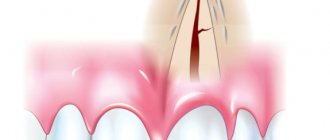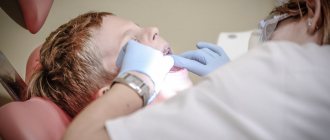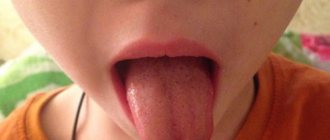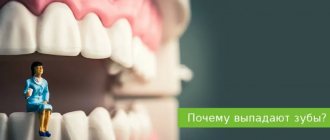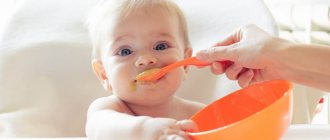- What to do if a child breaks a tooth?
- A child's tooth is dislocated.
- If a child knocks out a baby tooth, what should you do?
- Prevention of childhood dental injuries.
Children differ from adults by being more active and playful.
These properties allow them to quickly understand the world around them. But sometimes children's pranks lead to unpleasant consequences, such as a knocked out or chipped tooth. Injuries to the dentition can occur either due to negligence or as a result of weakening of the enamel. Whatever the reason, parents urgently need to solve this problem.
And the only sure way to avoid complications after a chipped tooth is to see a dentist.
What to do if a child breaks a tooth?
The first thing to do is to calm the child and examine for other injuries that require urgent medical attention. If these are not observed, then rinse your baby’s mouth with water, blot the injury site with a clean napkin, and also try to find the chipped part of the tooth.
If the pain is severe, the child should be given a pain reliever. If a red dot is visible on the tooth, this means that the nerve has been exposed. In this case, you should not give your child cold or hot drinks and go to the dentist as soon as possible.
If there is no red dot on the damaged tooth, it has not moved, and the jaw can close normally, then there is no particular danger. Nevertheless, it is still necessary to see a doctor, since the tooth has lost its protective layer and is now more susceptible to infections and all kinds of diseases. Without proper treatment, the nerve may simply die, resulting in the loss of the entire tooth.
The statistics for permanent teeth are as follows:
If the tooth is returned to its place within 30 minutes, it will take root in 90 percent of cases; if replantation is delayed for up to 2 hours, it will fail in 90 percent of cases. It is clear that during the first 30 minutes, first aid to the injured child will be provided by his parents. According to Polish researchers, the percentage of medical workers willing to replant a tooth at the site of injury is only 7 percent; the rest prefer to call parents to take the child to the dentist. And this is a waste of time, reducing the chance of engraftment.
Therefore, forewarned means forearmed. Tell your friends.
Tooth dislocation in a child
Tooth luxation is a displacement of the crown in its alveolus as a result of physical impact. This injury is especially common in children and is common among all types of dental injuries. Symptoms of a dislocation may include:
- displacement of the dental crown back, forward, sideways
- the tooth is rotated around its axis
- the child cannot close his jaw completely
- tooth tissues are separated from the gums
- the soft tissue around the tooth swells and bleeds
- the tooth is loose, but still stays in the socket
It is imperative to see a dentist, even if the tooth looks almost undamaged. There may be a broken root or damaged nerve inside it. Such a tooth can be saved, the main thing is not to put pressure on it and not to self-medicate.
Only a qualified dentist can correctly assess the damage and prescribe effective treatment. If you see a doctor within the next hour after receiving an injury, the chances of saving the tooth increase significantly.
Complete dislocation of primary teeth
In cases where a child has knocked out baby teeth, their replantation is not provided. After the examination, the dentist must take an x-ray to make sure there is no damage to the alveolar process or impacted dislocation. In the latter case, the tooth goes into the bone plate or the rudiment of the future molar.
In addition to visiting a doctor immediately after receiving an injury, you will need to undergo a dental examination several more times, after a week and a month, respectively, and also after 6 and 12 months from the date of tooth loss. In each case, an x-ray is also taken to monitor possible deviations in the formation of the molar.
What to do in such a situation
The problem of a missing tooth in cases where there are still several years left before the eruption of molars turns out to be very serious, and it has its own reasons. An orthodontist must carry out an examination after the wound in the gum has completely healed.
When eating, the chewing load is evenly distributed between all the teeth involved in the process, but in the absence of one or more teeth, an imbalance occurs and uneven loads are formed. As a result, teeth are much less resistant to caries.
In addition, the presence of emptiness automatically leads to a gradual displacement of the teeth towards the free space. The result of this phenomenon is often incorrect teething or deviation of their position from their intended place.
The orthodontist can offer a special children's prosthesis, which is a plate that fills the empty space, but is not inserted into the bone, as in implantology. Such an artificial tooth will not only take on part of the load, but will also prevent real teeth from moving apart.
If a child knocks out a baby tooth, what should you do?
In the case of baby teeth, we are not talking about restoring them or putting them back. It is not necessary to look for the knocked-out fragment. But it is necessary to take care of the molar tooth germ, which is located in the gum. You cannot injure it or allow it to get infected, so a visit to the dentist is mandatory.
If the baby accidentally knocks out a molar, it must be found and returned to the socket as quickly as possible. In this case, the tooth should be washed in saline solution or plain water, and also held by the crown part so as not to cause an infection.
The best and most predictable option is to return the tooth to the socket within the first 15 minutes. This increases the chance of its recovery to 90%. If you are afraid to insert a tooth yourself, then you should see a doctor as soon as possible.
In this case, the tooth must be transported in a suitable environment - saline solution, milk, water.
Instructions for trauma to a baby tooth:
- Call the UMGkids center and make an appointment soon.
- The doctor will restore the baby tooth with a composite material or, if the chip occurred within the enamel, polish the edge.
- If you find a broken piece, put it in water/saline/milk and take it with you. In some cases, a tooth fragment can be glued and its integrity restored. If the fragment is not found, the doctor will restore the baby tooth with a composite.
How can UMGkids doctors help if a tooth is broken?
- At the UMGkids center they will help you in case of any dental injury, we take the most complex cases.
- We follow international protocols that are designed specifically for trauma care.
- The doctor will conduct treatment using the most accurate digital diagnostic methods.
- The tooth will be restored using modern composite materials - there will be no trace left of the chip!
- After tooth restoration, the child will be able to chew and speak exactly the same as before the injury.
- If the tooth is mobile, it will be secured between adjacent teeth using splinting.
Is it worth the fuss?
Sometimes parents decide to leave everything as it is and do not rush to the doctor. We declare with confidence: the decision is strategically wrong. If even a small piece of enamel breaks off on a tooth, it will begin to hurt. Exposed dentin must be covered, otherwise bacteria will get inside. They will quickly destroy the dentin layer, and the infection will affect the pulp. The consequences of pulpitis are well known to everyone.
Just imagine what will happen if, due to such negligence, you have to remove the pulp from an immature tooth! It will remain thin and fragile and will have a very limited lifespan. After its loss, neighboring teeth will begin to occupy the vacated space, which means problems with bite are guaranteed. Remember that an implant can be installed no earlier than 18 years of age, which means that the bone tissue will undergo changes. In a word, any tooth injury is a good reason to see a dentist. Call without delay!
Prevention of childhood dental injuries
In order not to encounter the situations described above, you should take care in advance of the safety of the baby’s oral cavity. Remember that some dental injuries can be prevented by using simple protective measures:
- An excellent protection against injury during active games or sports is a helmet that not only protects the head, but also the teeth.
- To protect your child's teeth, use a mouthguard. This simple dental product provides as much as 85% protection.
- Talk to your children about the importance of being careful when playing. But don't intimidate them.
- Teach your child to fall without injury. Demonstrate how to tuck to avoid head and neck injuries.
- Provide your baby with healthy nutrition with all the necessary vitamins and microelements.
- Teach your child to brush their teeth regularly and visit the dentist every six months.
If you still failed to protect your baby from injury, you should contact your dentist as soon as possible. You can get qualified help at Aesculapius dentistry. In our dentistry you will find first-class equipment and modern treatment methods.
Four specialists work in one shift and they know their job very well. We work with each patient on an individual basis and provide a guarantee for all services. Absolutely all clients are satisfied with the level of service.
Maybe leave it as is? The child has no visible injuries
If the baby is not in pain, there is no bleeding and there is no wound on the gum, everything is probably fine. However, only a specialist can accurately determine this.
Possible consequences of dental trauma in children:
- Nerve damage could occur or an invisible crack may appear, which in the future will lead to a fracture of the coronal part.
- A loose tooth needs to be splinted to prevent it from falling out.
- A chipped piece of enamel will expose dentin, which does not always cause pain. But an infection gets into the place of the chip, and this is fraught with the development of pulpitis and periodontitis. In this case, proper treatment of baby teeth will be required.
We care about the comfort of young patients. They leave us happy. If you have any questions, call us.
What to do first
Regardless of the child’s well-being and the complexity of the injury, it is imperative to consult a doctor - to the emergency room, the nearest dental clinic, and if the physical condition of the victim is of concern and he cannot move independently, then you can call a doctor at home. Before examining a specialist, you need to calm the baby down and, if necessary, give an anesthetic. Further actions will depend on the nature of the damage.
When bleeding
If blood is flowing from a wound, it is not recommended to stop it for the first couple of minutes - pathogenic microorganisms that may have entered the hole due to damage will come out along with it. If bleeding continues, you should roll up a small piece of sterile bandage or gauze into a tampon, place it on the wound, and ask the child to clench his jaw.
It is important to know! When bleeding comes from a wound, you should not give your child acetylsalicylic acid, anti-inflammatory drugs, or others that thin the blood. Such “treatment” can result in blood loss.
If some time has already passed after the injury, and a blood clot has formed at the site of the defect, under no circumstances should you use rinses or apply a tampon. The resulting clot serves to protect the damaged area from pathogenic microorganisms.
Loss of a permanent tooth
If a child’s permanent tooth, front or molar, is knocked out, it doesn’t matter, it can be restored if it is quickly preserved. The found unit of the dentition should be immediately placed in a saline solution or in a solution intended for storing lenses. It is in this form that the tooth should be brought to the doctor within half an hour after it falls out. According to statistics, the survival rate in this situation can be about 90%. It is not recommended to rinse with water or place the tooth in water, or try to insert it into place yourself.
If a unit is partially knocked out and hangs on the gum, you can correct the tooth by carefully returning it to its original position. To fix it, you need to bite on a clean handkerchief or a piece of bandage. And immediately contact your dentist or emergency room.
If the milk unit is knocked out
If a baby tooth is knocked out, it can also be saved. By the way, not every clinic will have a doctor perform replantation of a mammary unit, especially for a one-year-old child who will not allow this procedure to be performed. In addition, it makes no sense to restore the loss if there is an active change in the bite - in order to make sure that the tooth was “ready” to leave the oral cavity, the dentist will prescribe an x-ray.
What consequences may there be
A piece of teeth knocked out in childhood can lead to the following complications:
- malocclusion: neighboring teeth will shift, preventing the formation of permanent teeth,
- speech defects: their risk especially increases with the loss of incisors, which take an active part in articulation,
- diseases of the digestive tract: the inability to thoroughly chew food leads to its insufficient processing by oral enzymes, swallowing in pieces, which over time provokes gastrointestinal diseases.
Also among the negative consequences can be noted: violation of the aesthetics of the dentition, the appearance of problems in communicating with peers, an increased risk of pathologies in neighboring units, frequent inflammation even after successful treatment.
